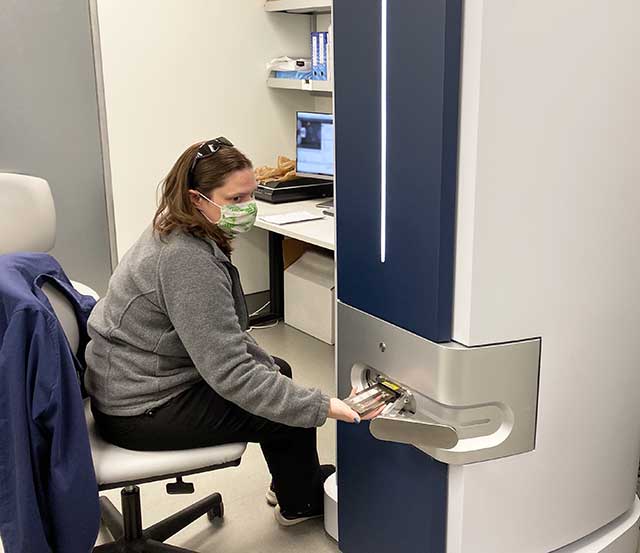Mass Spectrometry Molecular Imaging and Multi-Omics SR

The MSMIMO Shared Resource integrates three cooperative institutional facilities at Johns Hopkins University: The Applied Imaging Mass Spectrometry (AIMS) Unit, The Mass Spectrometry and Proteomics (MSP) Facility, and The Metabolomics Unit (MU). The overarching goal of the MSMIMO Share Resource is to provide cost-effective, state-of-the-art instruments, technologies and services for collaborations on novel mass spectrometry based molecular tissue imaging (spatialomic), metabolomic and proteomic applications to accelerate cancer research. Below are three examples of SKCCC applications from services each facility provides.
AIMS Unit
Chemotherapeutic treatment of pancreatic ductal adenocarcinoma (PDAC) patients with gemcitabine suffers from poor drug delivery and rapid metabolism, leading to poor outcomes. The AIMS Core developed quantitative tissue imaging of gemcitabine to evaluate drug delivery, distribution, and conversion to the active metabolite, gemcitabine triphosphate. Simultaneous quantitative MALDI imaging of gemcitabine (red) and gemcitabine triphosphate (green) in mouse models of PDAC revealed that gemcitabine accumulates in pancreatic tumors within 30 minutes post-injection, followed by rapid conversion to gemcitabine triphosphate, peaking in viable tumor regions at 1 hour (Tressler, Eshleman, Glunde et al, 2020).
MSP Unit
Phosphoinositide 3-kinase alpha (PI3Ka) is a lipid and protein kinase critical for initiating the AKT/mTOR signaling pathway and a key player in cancer pathogenesis that is frequently mutated in most cancers. Using isobaric mass tags (TMTs) the MSP Core quantified changes in phosphorylation sites in wild type and mutant PI3ka and identified the three active-site amino acid residues critical for PI3Ka substrate binding and catalysis (Maheshwari et al 2017, JBC 292:13541).
Metabolomics Unit (MU)
Unit is a new resource that will offer high throughput analysis of polar and non-polar metabolites using an Agilent 1290 infinity II UHPLC coupled to a Bruker impact II QTOF mass spectrometer (or an evolved version of this instrument) equipped with an ionBooster ESI source. Using this instrumentation, metabolites can be measured and identified in extracts of any biological tissue or fluid.
Leadership
Co-Directors
Chan-Hyun Na, M.S., Ph.D.
Kristine Glunde, M.S., Ph.D.
